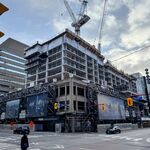The two pioneering Canadian LRT cities, Calgary and Edmonton, located in the western province of Alberta, are both planning a major shift in their design and operating philosophies.
Edmonton, Alberta’s capital, opened its first line in 1978; Calgary followed three years later.
Both systems, from the outset, adopted high-platform boarding. Edmonton’s stations have been somewhat simple and utilitarian, for the most part, apart from those in the subway section, while Calgary’s have tended to be elaborate and expensive.
Edmonton has about three miles of subway, extending from the northwest fringe of downtown to the University of Alberta, south of the center city. This approach was quite costly, and hindered significant extension of the line for a number of years. To this day, Edmonton Transit operates one long line from the northeast to the southern sector, with a short, recently opened branch to the northwest.
Calgary, from the outset, took a different approach to contain costs, utilizing a transit mall instead of a subway in the downtown, and generally limiting tunnels to short sections. Since 1981, Calgary’s system has grown extensively, culminating in two lines that serve the northwest, northeast, western, and southern sections of the city. The system has grown from its original 8 miles to just over 37 miles.
Siemens LRVs have been the car of choice in both cities, with newer models ordered as the original models pass their 30th anniversaries.
Both cities have recently decided, since low-floor operations can be implemented at significantly lower cost, to pursue this approach on two completely new lines. These will be completely separate operations from the existing high-floor lines, although transfer will be possible. That said, both Calgary Transit and Edmonton Transit have extensions to the existing high-platform routes on the drawing boards, for future construction.
Another advantage of low-floor LRT is that it can be situated on local streets, on reserved track, with less obtrusive stations more acceptable to local residents.
[...continues at length with maps, diagrams and detail...]
http://www.railwayage.com/index.php...algary-edmonton-adopt-low-floor-approach.html
A low floor vehicle offers the same load, unload rate as a high-platform vehicle, at a much reduced cost. So why would you want to complicate both forward compatibility to shared running with RER and street running?




